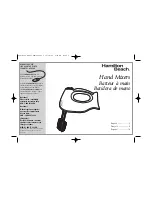
(5) CHANNEL PEAK LED
The Peak LED illuminates when
a channel input is overloading.
It detects the peak level after
the Equalizer Controls (6) and
will light just before clipping to
warn that the signal is
approaching overload. You do
not want the Peak LED to light
except very intermittently. If it
lights persistently, reduce the
Gain Control (4)
. If the Gain
control is set to minimum, the
output level of the preceding
equipment should be lowered.
(6) EQUALIZER CONTROLS
All channels are fitted with a
three-band EQ - High, Mid and
Low controls. All three bands
have up to 15 dB of cut and
boost, with a center detent for
OFF. The frequency response is
flat when all three EQ knobs
are in the center detent
position. The High and Low
shelving controls have their
frequencies fixed at 12 KHz and
100Hz respectively and the Mid
control is fixed for peak
response at 1KHz. The
channel EQ is a valuable
feature of the mixer as it allows
the user to control the tonal
characteristics of each channel
separately. For example,
boosting the Low can fatten the
sound, add bass to vocals, or
extra punch to bass, drums and synths.
The Mid control can be used to increase midrange, fatten
guitars, or bring warmth to vocals. Adjusting the High control
can provide a crisp sounding high end. Another very important,
yet often overlooked technique is to use the EQ to subtract
from the mix. Cutting the High control can reduce unwanted
sibilance, hiss, cymbals, or high frequency feedback, while
attenuating the Mid or Low can also eliminate feedback or clear
up a muddy sounding mix. The Mid Freq control can also be
used to reduce any feedback. Cutting the High and Low, then
pushing up the
Channel Volume Control (11)
is equivalent to
mid range boost!
[Note: Always reset a channel’s input Gain Control (4) after
altering the amount of equalization to avoid input overload.]
The key to successful equalization is to avoid excess. Too
much equalization on the input channels will result in a mix that
is smeared together with nothing specifically defined. During
rehearsals, experiment with the equalizer controls on various
instruments, vocals and combinations of these mixed together
to become familiar with various equalizer settings.
(7) EFFECTS SEND CONTROL
This control adjusts the level of signal sent to the Effects Send
5
C O N T R O L S A N D C O N N E C T I O N S
(1)
(1) CHANNEL 1 & 2 INPUTS
These electronically balanced XLR inputs are designed to
accept signals from any balanced or unbalanced low
impedance (Low Z) microphone. They can also be used to
accept line level signals when the Gain is turned close to
minimum. The XLR jack is configured: Pin1 = ground, Pin 2 =
positive (+), Pin 3 = negative (-).
The 1/4” unbalanced inputs are designed to accept unbalanced
Mic or Line level signals such as those from keyboards, drum
machines, or samplers. It will be necessary to adjust the input
Gain Control (4)
to achieve a nominal operating level with no
clipping. The Gain Control should be set closer to minimum
when using Line level input signals. All four inputs can be used
simultaneously to accommodate the use of four audio sources.
(2) CHANNEL 3/4 & 5/6 STEREO INPUTS
These 1/4” and RCA unbalanced inputs are designed to accept
line level signals (max 1V / 2.3dBm) such as those common to
CD/tape players, keyboards, direct outputs and home stereo or
DJ equipment.
Channel 3/4 1/4” inputs can also be used as standard mono
line inputs by plugging into the L input only. This signal will be
routed equally to the Pan control and the left and right outputs
in the same way as the standard line input channels.
For each channel there are separate A and B stereo inputs.
Either A or B inputs can be selected using the Input Selector
Switch. This allows the user to switch to a different input
source instantaneously. This is very helpful for DJ when
switching to different source material or for musicians who
change instruments.
(3) INPUT SELECTOR BUTTONS
These select either A or B input sources for channels 3/4 and
5/6.
(4) GAIN CONTROL
The Gain control adjusts the input sensitivity (channel gain) of
the inputs. This control can be adjusted to accommodate input
signals from a wide variety of sources, from the high outputs of
keyboards and drum machines to the small signal outputs of
microphones. The best balance of S/N and dynamic range will
be achieved if you adjust the Gain control on each channel
separately so that the
Channel Peak LED (5)
almost lights.
(2)
(3)
(4)
(6)
(7)
(8)
(9)
(11)
(10)
(5)
Содержание PMX-420
Страница 1: ...PMX 420 O W N E R S M A N U A L 6 Channel Powered Console Mixer ...
Страница 10: ...BLOCK DIAGRAM 10 ...






























